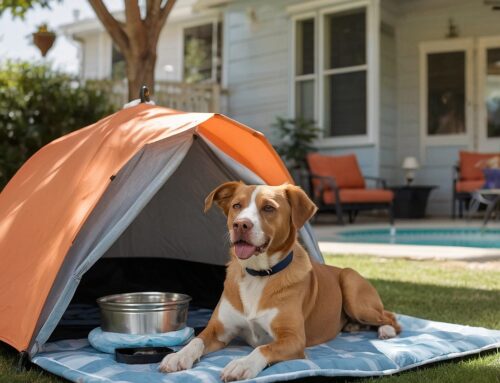It only takes a moment: just a second of turning your head, taking a quick potty break, or talking to someone, and your dog be in distress in the water. This article will cover different breeds that are natural swimmers along with breeds who are not along with tips every pet parent should know when it comes to bodies of water and their dogs.
Breed Differences
Not all dogs are born and bred swimmers, but there are some who clearly enjoy, and demonstrate prowess, in the water. If you have any of these breeds, it’s still important to watch them closely. Among swimming breeds are the following:
- Golden Retrievers
- Chesapeake Bay Retrievers
- Portuguese Water Dogs
- Newfoundlands
- Irish Water Spaniels
- Nova Scotia Duck Tolling Retriever
On the other hand, brachycephalic, or short nose breeds, are not natural swimmers and can get in trouble in the water, quickly. Some of these breeds include the following:
- Bulldogs
- Boxers
- Pugs
- French Bulldogs
- Boston Terriers
- Pekingese
Finally, there are short-legged dogs which, no matter how hard they paddle, their little legs do not propel them fast enough to ensure their safety in the water. Some of these breeds include:
- Basset Hounds
- Corgis
- Dachshunds
General Water Safety Guidelines
There are some guidelines that hold true no matter what kind of water your dog will be swimming in.
- Never leave your dog alone or unattended. Inattention for just a moment can mean the difference between life and death.
- Make exiting easy and train them where they can enter and exit.
- Put a life jacket on your dog. Not only will a lifejacket keep your dog afloat, it also makes it simple for you to grab hold of him if necessary.
- Bring water and a collapsible bowl. Thirsty dogs will drink anything. Salty ocean water, dirty pond, lake or river water, and chlorinated pool water are neither quenching nor healthy for your dog.
- Make him rest. Swimming is hard work, both for humans and dogs. In the heat of the summer, the work of swimming can tire your dog, so he needs to take breaks and rest. Head for the nearest shade tree so you both can recharge.
- Wash him off. After his swims, be sure and wash him off thoroughly to prevent salt and harmful chemicals from irritating his skin.
Teaching Your Dog to Swim
Aren’t all dogs natural swimmers? Some surely are, but it’s still important to carefully orient your buddy to the water safely. Here’s how:
- Keep him on a leash.
- Find a shallow spot away from other people.
- Accompany him into the water.
- If he starts to paddle with his front legs, lift his hind legs which will guide him to float while moving through the water.
Every water source carries its own unique issues that will influence your dog’s safety. Specific concerns for each type of water follow.
Swimming Pools
Nationwide, backyard swimming pools claim an estimated 5000 family pets each year, all of which are preventable deaths. It’s not safe to assume that just because your dog can swim, he’ll be safe in your pool when you’re not watching him. Swimming is fine but getting out of the pool is another matter. Dogs automatically swim to the side, and if they cannot readily get out, and they’ll tend to panic. So, always be there to show them the way to the steps and assist.
Ocean Beaches
Currents and riptides that can whisk a dog, or a human, out to sea are the big concern for ocean beach swimming, so be sure and evaluate the conditions before allowing your pet in the water. In addition, prevent your dog from drinking ocean water as it is toxic. Finally, steer him away from any washed-up fish or other debris as they could contain harmful substances.
Rivers, Lakes, and Ponds
If the surface of the water is blue-green with algae, don’t let your dog swim in it as it can make him sick. If swimming in a river, check the current to be sure your dog is strong enough to handle swimming in it. Keep him away from fishing equipment, boats, and other items that could possibly be dangerous and harm him.
On the Boat
There’s nothing like enjoying a hot summer day on the water in a boat, but when you bring your buddy along, you need to take specific precautions. Here are guidelines for keeping your dog safe when out on a boat.
- Life jacket, life jacket, life jacket: need we say more?
- Dramamine? Would you believe dogs can get seasick, just like humans? You might want to talk to your vet before your boating adventure so see about having some meds on hand, should you need them.
- Eagle eye: always keep your eye on your dog.
- Can your dog handle a boat ride? Some dogs are too anxious or hyper and have trouble settling in for a boat ride. See if you can take a “test run” to see if your dog can handle boating.
- Sunscreen: make sure it is the kind especially made for dogs; human sunscreen contains ingredients that are harmful and irritating to dogs.
- Treats, water, and bowl: Bring plenty of water and a collapsible bowl. Also, be sure to have plenty of yummy treats.
- Towel: You’ll never know when you might need to dry him, or you, off.
- Leash: You probably won’t go for a walk on the boat, unless it’s a very big boat, but if you dock, you’ll be glad you have that leash handy.
- First aid kit: Put together a doggy first aid kit and be sure to have it with you.
- Escape plan: Plan what you’ll do to escape with your dog if there should be an emergency.
So along with the fun in the sun and the splash in the water is the need to take extra special care of your canine friend. Follow the guidelines here to ensure your dog is safe during all your water activities.








